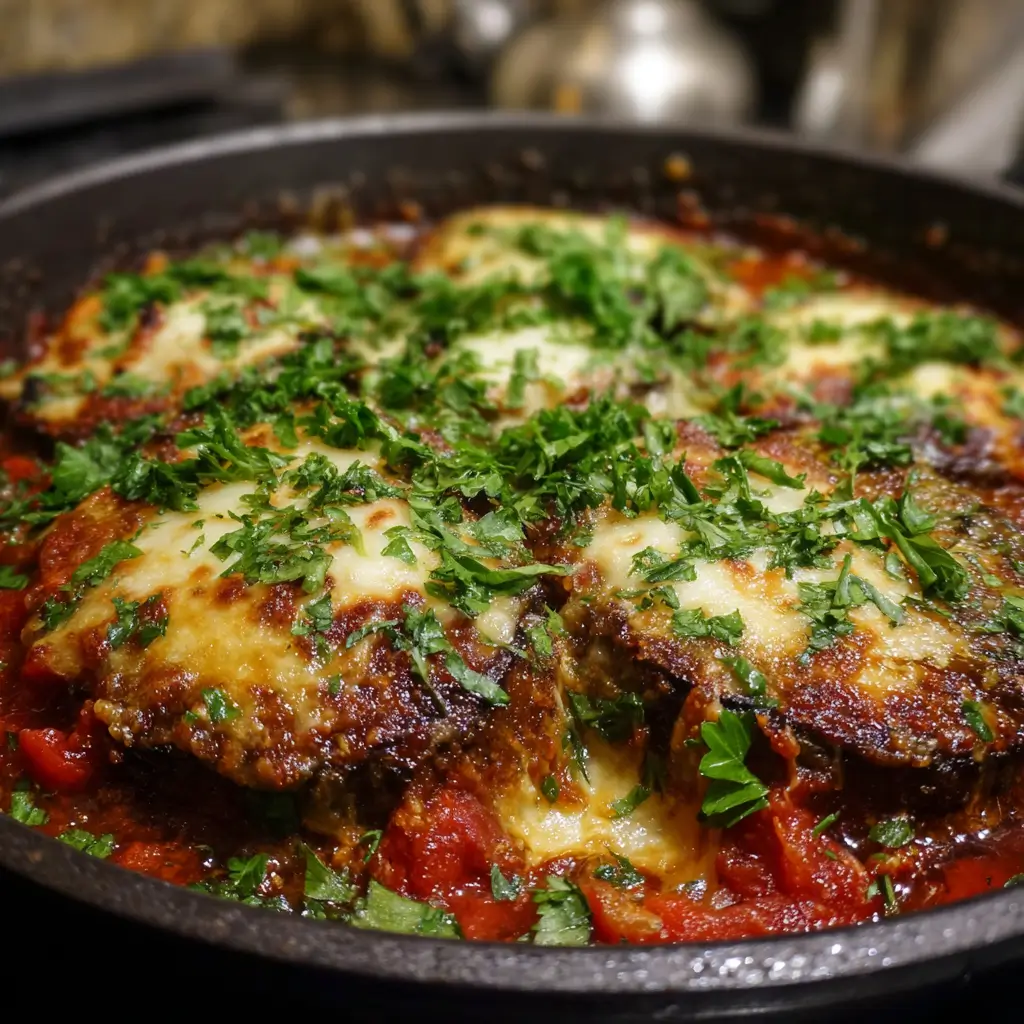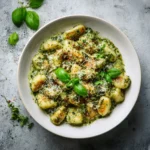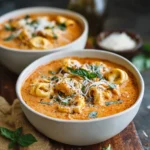Eggplant Parmesan: A Classic Italian-American Comfort Dish
Eggplant Parmesan, also known as melanzane alla parmigiana, is a beloved staple of Italian and Italian-American cuisine. This rich, hearty casserole features layers of tender fried or baked eggplant slices, smothered in tangy tomato sauce, melted mozzarella cheese, and fragrant Parmesan. Baked to golden perfection, it’s a dish that combines texture, flavor, and comfort in every bite. Whether served as a main course with a side salad or as a satisfying vegetarian centerpiece, Eggplant Parmesan continues to win hearts across kitchens worldwide.
The History of Eggplant Parmesan
The origins of Eggplant Parmesan trace back to southern Italy, particularly the regions of Campania and Sicily, where eggplants have been cultivated for centuries. The name “Parmesan” refers not to the city of Parma, but rather to Parmigiano-Reggiano, the famed hard cheese from northern Italy that is often used generously in the dish. However, the full title “melanzane alla parmigiana” actually means “eggplant in the style of Parma,” though the dish itself likely evolved further south.
Eggplants were introduced to Italy through Arab traders during the medieval period, and over time, they became deeply integrated into regional cuisines. The concept of layering vegetables with cheese and tomato sauce was popularized after the introduction of tomatoes to Europe from the Americas in the 16th century. However, early versions of this dish may have predated tomatoes, using herbs, olive oil, and cheese instead.
It wasn’t until the 19th and 20th centuries that the modern version of Eggplant Parmesan emerged, especially as Italian immigrants brought their culinary traditions to America. In the United States, the dish evolved with richer cheese blends, more tomato sauce, and adaptations to suit local tastes. Today, Eggplant Parmesan stands as a symbol of Italian-American fusion—a comforting, family-style meal that celebrates simplicity and bold flavors.
Ingredients Breakdown
The beauty of Eggplant Parmesan lies in its simple yet high-quality ingredients. Each component plays a vital role in building the dish’s complex textures and savory depth. Here’s a detailed look at what goes into a traditional recipe:
- Eggplants: The star of the dish. Choose firm, glossy eggplants with smooth skin. Medium-sized ones are ideal—large enough to slice but not so big that they’re seedy and bitter.
- Salt: Used in the crucial step of sweating the eggplant to draw out moisture and reduce bitterness.
- All-purpose flour: Helps create a light coating before breading, aiding adhesion of the egg wash.
- Eggs: Whisked to form the binding layer between flour and breadcrumbs.
- Breadcrumbs: Preferably Panko or Italian-style for a crisp, golden crust. Can be seasoned or unseasoned.
- Grated Parmesan cheese: Adds umami and richness; authentic Parmigiano-Reggiano is ideal.
- Fresh basil: Offers aromatic freshness. Can be layered in the sauce or used as garnish.
- Marinara sauce: A robust, slow-simmered tomato sauce forms the saucy backbone. Homemade is best, but high-quality store-bought works too.
- Mozzarella cheese: Freshly shredded low-moisture mozzarella melts beautifully. Some recipes use fresh mozzarella slices for creaminess.
- Olive oil: Extra virgin olive oil is used for brushing or shallow frying the eggplant, adding fruitiness and depth.
- Garlic and onions: Often included in the sauce for aromatic complexity.
- Dried oregano and red pepper flakes: Common seasonings that enhance the savory profile.
Step-by-Step Recipe
Ingredients
- 2 large eggplants (about 2 lbs / 900 g)
- Kosher salt (for sweating)
- 1 cup all-purpose flour
- 3 large eggs, beaten
- 2 cups breadcrumbs (Panko or Italian-style)
- ½ cup grated Parmesan cheese
- 1 teaspoon dried oregano
- ½ teaspoon black pepper
- ½ cup olive oil (or more, for frying)
- 4 cups marinara sauce (homemade or store-bought)
- 3 cups shredded mozzarella cheese
- ¼ cup chopped fresh basil (plus extra for garnish)
- 2 cloves garlic, minced (optional)
Directions
- Prepare the Eggplants: Slice the eggplants crosswise into ¼-inch thick rounds. Arrange them on a wire rack or paper towels in a single layer. Sprinkle both sides generously with kosher salt. Let them sit for 30–60 minutes to draw out excess moisture and any bitterness. Rinse the slices under cold water and pat dry thoroughly with paper towels. This step is essential for preventing soggy eggplant.
- Preheat Oven: Preheat your oven to 375°F (190°C). Lightly grease a 9×13-inch baking dish with olive oil or non-stick spray.
- Set Up Breading Station: Prepare three shallow bowls: one with flour, one with beaten eggs, and one with a mixture of breadcrumbs, ¼ cup Parmesan, oregano, and black pepper.
- Bread the Eggplant Slices: Dredge each eggplant slice first in flour (shaking off excess), then dip in egg, allowing excess to drip off, and finally coat in breadcrumb mixture, pressing gently to adhere. Place breaded slices on a clean tray.
- Cook the Eggplant: You can either pan-fry or bake the slices:
- Pan-frying: Heat olive oil in a large skillet over medium heat. Fry eggplant in batches for 2–3 minutes per side until golden brown. Drain on paper towels.
- Baking (healthier option): Brush both sides of breaded slices with olive oil and arrange on baking sheets. Bake for 20–25 minutes, flipping halfway, until golden and crisp.
- Warm the Sauce: In a saucepan, heat the marinara sauce with minced garlic (if using) and half the fresh basil over low heat. Simmer for 10 minutes to blend flavors.
- Assemble the Casserole: Spread ½ cup of sauce on the bottom of the prepared baking dish. Layer with a single layer of cooked eggplant slices, slightly overlapping. Top with 1 cup of sauce, 1 cup of mozzarella, and a sprinkle of Parmesan. Repeat the layers two more times. Finish with a final layer of sauce, remaining mozzarella, and a generous topping of Parmesan and breadcrumbs.
- Bake: Cover the dish with aluminum foil and bake for 25 minutes. Remove the foil and bake for another 15–20 minutes, until the top is bubbly and golden brown.
- Rest Before Serving: Let the Eggplant Parmesan rest for 10–15 minutes after baking. This allows the layers to set, making it easier to cut and serve without falling apart.
- Garnish and Serve: Sprinkle with fresh basil. Serve warm with garlic bread, a green salad, or pasta.
Tips for Perfect Eggplant Parmesan
- Sweat the eggplant well: Don’t skip salting. It removes bitterness and prevents sogginess.
- Pat dry thoroughly: Moisture is the enemy of crisp breading. Dry slices ensure better adhesion and less oil absorption.
- Use fresh, quality cheese: Low-moisture mozzarella melts evenly. Fresh mozzarella adds creaminess but can make the dish watery—pat it dry if using.
- Don’t skimp on sauce: Enough sauce keeps the dish moist and flavorful throughout.
- Avoid overcrowding layers: Keep layers even and balanced to ensure consistent cooking.
- Let it rest: Allowing the dish to settle after baking improves texture and makes serving cleaner.
- Make ahead: Assemble up to a day in advance and refrigerate. Add 10–15 minutes to baking time if starting cold.
- Freeze for later: Fully assembled or sliced, Eggplant Parmesan freezes well for up to 3 months. Thaw overnight in the fridge before reheating.
Variations and Customizations
Eggplant Parmesan is wonderfully adaptable. Here are some creative twists to suit different tastes and dietary needs:
- Gluten-Free: Use gluten-free flour and breadcrumbs. Almond flour or crushed cornflakes work well.
- Vegan: Substitute eggs with a flax or aquafaba wash, use vegan mozzarella and Parmesan, and choose plant-based breadcrumbs.
- Low-Carb/Keto: Skip breading altogether. Season eggplant slices with herbs and roast until tender before layering.
- Extra Cheesy: Add ricotta or provolone between layers for added creaminess and flavor.
- Meat Lovers’ Version: Incorporate layers of cooked Italian sausage, meatballs, or pepperoni for a heartier meal.
- Ratatouille-Style: Mix in zucchini, bell peppers, and mushrooms for a Provençal-inspired twist.
- Individual Portions: Make mini parmesans in ramekins or muffin tins for elegant servings.
- Grilled Eggplant: For a smoky flavor, grill the slices instead of frying or baking.
- Spicy Kick: Add red pepper flakes to the breadcrumb mix or use spicy marinara sauce.
Health Considerations and Nutritional Value
Eggplant Parmesan can be a nutritious dish when prepared mindfully. Here’s a breakdown of its health aspects:
Nutritional Highlights
- Eggplants: Low in calories and rich in fiber, antioxidants (especially nasunin, found in the skin), and potassium. They support heart health and digestion.
- Tomato Sauce: High in lycopene, an antioxidant linked to reduced risk of certain cancers and heart disease. Cooking enhances lycopene availability.
- Cheese: Provides calcium, protein, and vitamin B12. However, it’s also high in saturated fat and sodium—moderation is key.
- Olive Oil: A source of heart-healthy monounsaturated fats and anti-inflammatory compounds.
Caloric and Macronutrient Profile (Per Serving, Approx. 8 Servings)
| Nutrient | Amount |
|---|---|
| Calories | ~350–450 kcal |
| Total Fat | 20–25 g |
| Saturated Fat | 8–10 g |
| Carbohydrates | 30–35 g |
| Dietary Fiber | 6–8 g |
| Protein | 15–18 g |
| Sodium | 600–900 mg |
Health Tips
- Reduce Oil: Baking instead of frying cuts down significantly on fat and calories.
- Lower Sodium: Use low-sodium tomato sauce and cheese, and rinse eggplants well after salting.
- Boost Veggies: Add spinach, mushrooms, or roasted red peppers to increase fiber and nutrients.
- Portion Control: Serve with a large salad to balance the meal and avoid overeating.
- Dairy Sensitivity: Opt for lactose-free cheese or nutritional yeast as a Parmesan substitute.
Frequently Asked Questions (FAQ)
Can I make Eggplant Parmesan without frying?
Yes! Baking the breaded eggplant slices on a parchment-lined tray brushed with olive oil yields a crispy texture with less fat. Roasting or grilling are also excellent oil-free alternatives.
Why is my Eggplant Parmesan soggy?
Sogginess usually results from insufficient moisture removal. Always salt and dry the eggplant thoroughly. Over-saucing or skipping the resting step can also contribute.
Can I use frozen eggplant?
Fresh is best, but frozen breaded eggplant can be used. Thaw and re-crisp in the oven before layering. Note that texture may be softer.
How long does Eggplant Parmesan last in the fridge?
Stored in an airtight container, it lasts 4–5 days. Reheat in the oven at 350°F for best texture.
Can I freeze Eggplant Parmesan?
Absolutely. Freeze before or after baking. Wrap tightly in foil and place in a freezer-safe container. Thaw in the refrigerator overnight before reheating.
What can I serve with Eggplant Parmesan?
Classic pairings include spaghetti, garlic bread, Caesar salad, or a simple arugula salad with lemon vinaigrette.
Is Eggplant Parmesan vegetarian and gluten-free?
It is naturally vegetarian. To make it gluten-free, use gluten-free breadcrumbs and flour.
Can I use different cheeses?
Yes. Try fontina, provolone, or smoked mozzarella for variety. Ricotta adds creaminess when layered between eggplant slices.
Why do you salt eggplant before cooking?
Salting draws out moisture and reduces bitterness, especially in older eggplants. It also helps prevent excessive oil absorption during frying.
Can I make it ahead of time?
Yes. Assemble up to 24 hours in advance and refrigerate. Add 10–15 minutes to baking time. You can also fully bake, cool, and reheat later.
Summary
Eggplant Parmesan is a timeless, soul-warming dish that marries tender eggplant, rich tomato sauce, and melted cheese into a harmonious casserole. Rooted in Italian tradition and perfected in American kitchens, it’s a celebration of flavor, texture, and home cooking.










